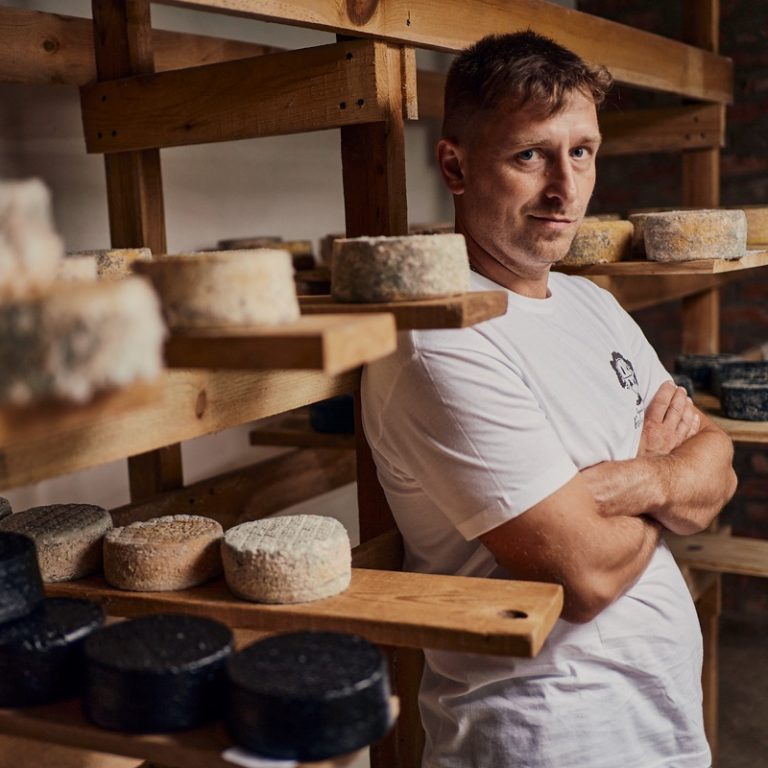Oleksandr and Maryna Blonski are from eastern Ukraine. At the beginning of the Russian-Ukrainian War, they left Luhansk and settled in the village of Vovnianka in Poltavshchyna, where they started their own business from scratch. They founded a goat farm and a farm-to-table cheese factory, which produces soft and aged cheeses according to their own recipes.
Oleksandr and Maryna Blonski breed goats, make cheese from their milk and receive tourists at their farm. Until 2014, they lived in a city apartment in Luhansk. Because of the Russian-Ukrainian War in eastern Ukraine, they were forced to leave.
Maryna and Oleksandr met in a restaurant. She worked as an administrator there, and Oleksandr was a chef.
— The first cheese was made back in Luhansk. We had our own cheese factory at the restaurant. And the first attempts were made right there. A Georgian friend who was a chef passed on the basic methods of making bryndza and sulguni. And then we developed them ourselves by trial and error.
After the restaurant, Oleksandr worked as a crisis manager. He rescued failing projects and revived them. Maryna used her experience to help start-ups.
— We had been involved in freelance work for the previous three years (in Luhansk — ed.). And then we decided to become cheesemakers and farmers.

At the beginning of the war, Maryna, who was pregnant at the time, was first to leave the occupied territorу to go and stay with her parents. Oleksandr soon joined her. In the village of Lozno-Oleksandrivka in the Ukrainian-controlled part of the Luhansk region, they stayed for a week at first, then for a month. In the end, they stayed for almost a year. They lived together with Maryna’s large family and Oleksandr’s relatives — 12 people altogether.
— I was saying to the last: “I won’t leave my apartment for anywhere!”. But, when there are 24 shells of hailing over your head, you start thinking about your own life. After all, with your head and hands you can earn money anywhere. And the examples of Ossetia and Transnistria were proof that we had to leave.
After the birth of their daughter Zlata, the couple decided that they needed to start their own business. Initially, they bought milk for the last 330 hryvnias of the family budget. They were cooking the cheese in a pan on the hearth or on a wood stove in the winter time. Oleksandr was selling cheese at the market, but in the frontline village it was not in great demand.

Vovnianka
The family started to think about moving to their own house. They were choosing between western and central Ukraine. The only thing that was indisputable was that it should be a house in a village.
— The city works on a format of hired labor. I was no longer interested in going to work for someone. And buying an apartment in the city is unrealistic. I lived in the city for 30 years and I wanted to go to the village, to be engaged in cheese production, farming, and animal husbandry.
The opportunity to start searching for a house came when the family arrived in the Poltava region, to stay with Oleksandr’s family. They brought the great-granddaughter to show to the family, and in the end they drove more than 600 kilometres on the roads of the region in three days. They stopped at the 29th house that they viewed in Vovnianka.
— Why Vovnianka? It just turned out that way. The house had the combination of a good price and quality. We arrived to find a big house, big windows, high ceilings. A large, spacious garden. All the houses we had viewed were wooden outbuildings on top of each other. A hen house, sub hen house, a duck house, something for a dog. And here we saw a big, unlittered, spacious garden.
They first came to Vovnianka in early May.
— We arrived, and there was green grass around, it was cosy and clean. We came out of the house, and Maryna said: “I want this house!”.
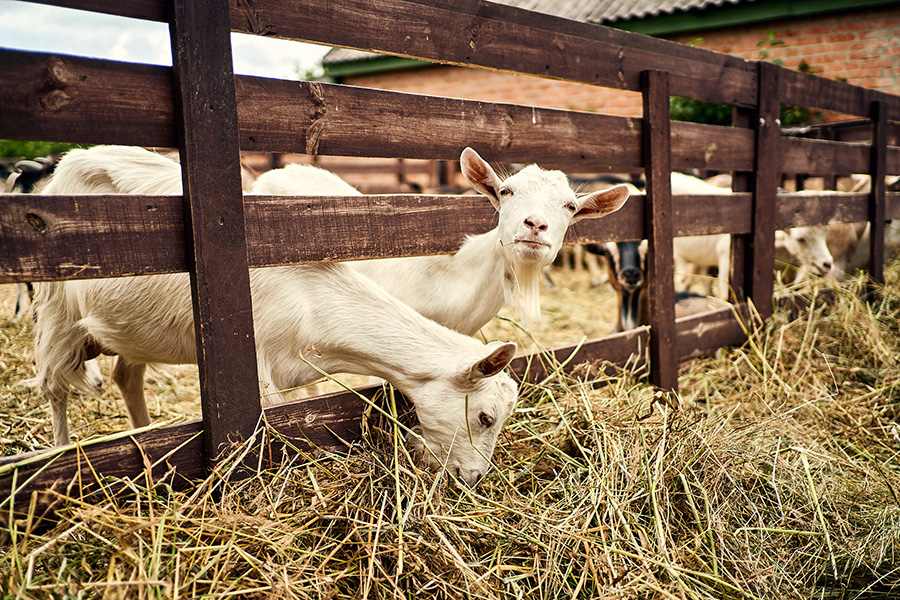
They had to compromise. At first they were looking for a village with well-developed infrastructure. But in Vovnianka there is neither a kindergarten nor a school. The Blonskis have two children: 5-year-old Zlata, and Volodymyr, who is 8 months old. Zlata is called the “main guide”: together with her parents she shows the farm to tourists. The baby boy spends a lot of time in the arms of his mum or dad.
In Vovnianka their production began with a 300-litre cheese vat and two refrigerators.
The Blonskis used the IDP resettlement programmes to start their own business. With these funds, they purchased stainless steel equipment and furniture for the production facility. They also began large-scale construction of a two-story cellar for cheese aging.

In two years, the Blonski family cheese factory built up enough customers. Now they are the owners of a fully-fledged business producing of artisanal cheeses. In the farmyard there are places for cooking, fermentation and the aging of cheese. Packaging and tastings take place here as well.
— They say: “A village! What were you thinking? Who will come to you?”. And I say it’s just a spot on the map, just geography. Doesn’t matter whether it’s Vovnianka or Luhansk. Because the main thing is what you do. And you have to love what you do. Then the success will come.
Initially, Oleksandr was buying milk for cheese near Vovnianka, from 40 villagers who kept goats. But the lack of milk quality control forced him to start his own herd. Today the farm has more than 50 animals, including 22 dairy goats. Maryna looks for clients, organises orders, and packs and sends goods. She also monitors the grants to support small businesses. Oleksandr takes care of animal feeding and produces the cheese.
The cheesemaker claims that it was very difficult to find a vet specialising in goats in and around Vovnianka. Therefore, in the first year of kidding, he spent a month preparing by watching videos on YouTube. He studied all the options for complications during pregnancy and goat labour, and all of this proved useful to him. Now the goats are visited by the veterinary service. Twice a year they are given routine vaccinations and tests.
— We chose goat’s milk, because you will not surprise or interest anyone with dairy products from a cow nowadays, and goat’s milk was a novelty, it was interesting and useful.
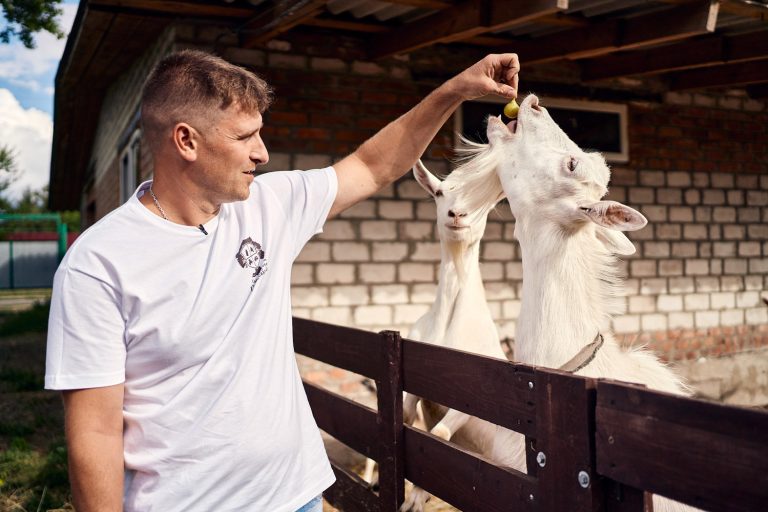
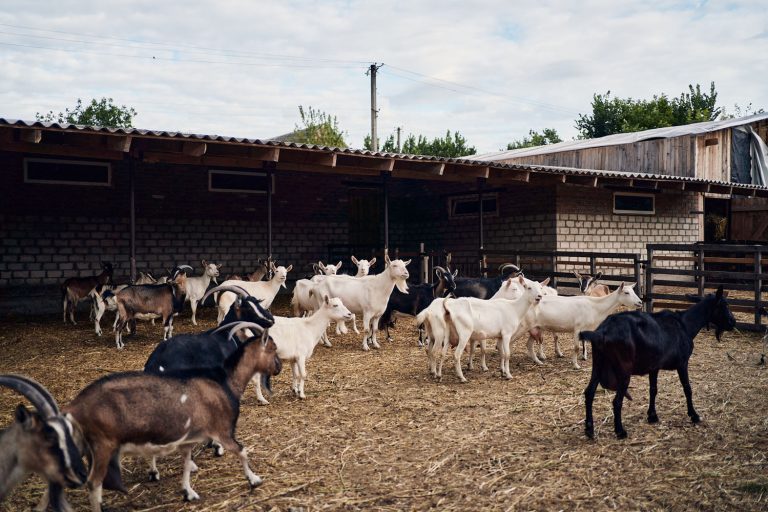
slideshow
Oleksandr says that the choice of goat was also pragmatic. It is easier to feed a goat than a cow. In proportion to its weight, one goat gives more milk than a cow. The Blonskis’ goats give 2-3 litres of milk a day. Moreover, the loss of a goat is not so detrimental to the farm’s profits.
— If a cow dies, God forbid, the owner is desperate. Because it’s the only source of income, and 600 kg are lost at once. If it’s one or two goats, God forbid, you will still be able to cook soup. It’s not like all ten of them at the same time.
They are milked in the evening and in the morning, and they feed all day.
— A goat is an animal that has to feed the whole day. After two hours she has had enough of one type of food and she needs to constantly be fed with new food. That’s why we grow grasses: sudan grass, burclover, etc., and we mow meadow grass. They like to eat barley straw. So the goat will eat all day, will eat a lot, and will give you milk.
The animals are kept in an enclosure, and fed with mowed grass as there is no place to graze, since the surrounding lands are owned by someone and plowed. The goats can jump freely in a huge open-air enclosure.

Cheese production
— We are still buying more milk, because there is not enough of our own. We take it from reliable housewives and regularly test the milk in a mini-laboratory. We plan to breed 50 dairy goats and to work only with our milk.
The Blonskis have their own ‘Ecomilk’ mini-laboratory. Milk is checked for fat content, water content, protein, and the pH level. Aside from that they monitor mastitis by using reagents.
Oleksandr calls the cheese vat, originally brought from Luben, “our breadwinner”. The cheese is cooked in it on firewood, according to the old method. The total volume of the vat is 300 litres. The maximum amount of milk processed by the cheesemakers per day is 900 litres.
Milk is heated to prepare the cheese. Then a natural enzyme for milk coagulation is introduced into the cheese curd, which is then cut, and the resulting cheese curd is split into molds. The time it is kept in the mold depends on the type of cheese you want to make. Some cheese is pressed. Then the finished young raw material is sprinkled with salt or poured with brine.
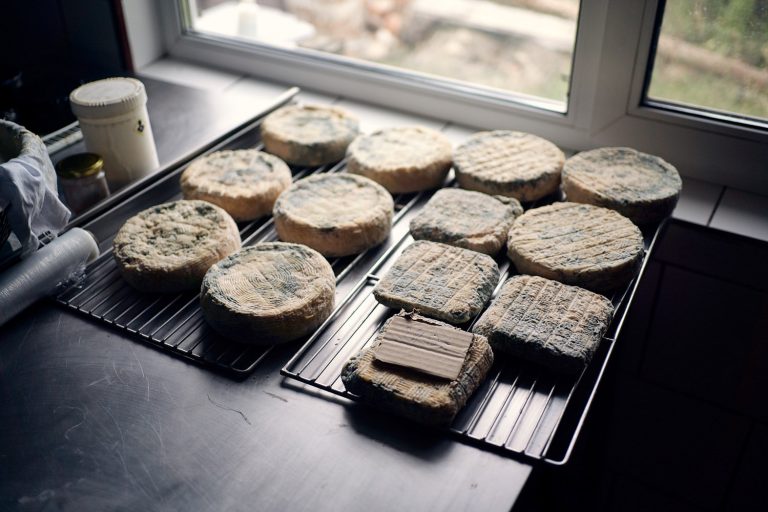
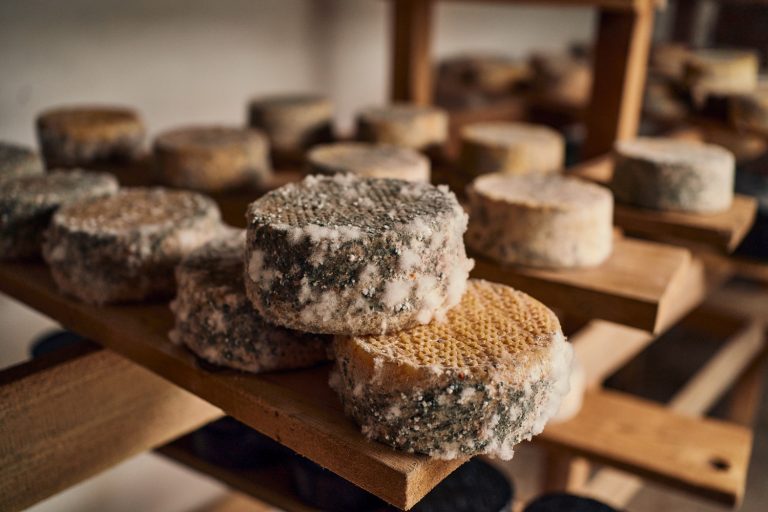
slideshow
Oleksandr says that he can spend the whole day making cheese.
— Let’s say, at 6 I went to collect milk, came back, and our milk arrived. I started cooking at 9, and I don’t leave the cheese until 6 o’clock in the evening. There is a lot of manual work in cheese production. And this is not due to a lack of money for ‘smart’ modern equipment. We do not want to turn our business into a factory that churns out identical products.
The average production volume is 200-300 litres of milk every three days. That’s more than 240 kilograms of cheese a month. In order for it to mature and to be stored properly, a two-storey temperature-controlled cheese cellar was built, where cheeses are aged.
Different cheeses need different conditions for proper maturation. Those with mold and without skin require warmth and moisture for the germination of penicillin in the first stage. For hard and extra-hard cheese with a skin, on the contrary, cold and moderate humidity are suitable. The skin of hard cheeses is washed after drying and they are placed in the cellar for maturation.
The six-metre cheese cellar is filled with hard and extra-hard cheeses after salting and drying the cheese skin. The Blonskis cover them with a paraffin film, which protects the block of cheese from mold formed on the outside.
— We age it for three to six months. We experimented with aging it for a year, but for this, you should make a big block, at least 8 kilograms. We mostly make extra-hard cheese in one-kilogram blocks, this is “Summer Farm” and “Depository” — the one that we put on deposit.
The Blonskis’ depository gives customers the opportunity to buy young cheese and leave it to mature in the cellar for at least six months. Buyers get the cheese in the finished extra hard form. Thus, it is possible to save money, because the finished extra-hard cheese is more expensive.
All the Blonskis’ cheeses are artisanal, with their own name and history. They produce six basic types and sometimes experiment. The young goat cheeses are “Picadon” and “Shabishu”, with different types of mold, and up to two months’ maturation. The soft cheeses are the “Fresh” feta type and a soft cream cheese. The hard types are “Summer Farm”, and a variation which is smoked on fruit chips. They recently began to make “Summer Farm with basil”. They also make cheese with fenugreek from a mixture of cow and goat’s milk. The spice gives the cheese a nutty flavor, and they grow it themself. They also have a hard cheese made only from goat’s milk called “Me-ke-ke”.

The Blonskis’ attention to detail
Oleksandr and Maryna say they look at cheese from the consumer’s perspective. Therefore, “Fresh” cheese, which is similar to feta, is canned in pieces with olive oil in jars, with olives. They say it’s almost a ready-to-use base for Greek salad, you just need to add vegetables. Cream cheese that is similar to ricotta is salted, herbs are added, and so it is convenient to spread on sandwiches, add to pasta, etc.
— We freeze ricotta, because it can be stored in the refrigerator for no more than two days. This is the only cheese that hardly changes after freezing. In addition, since we mostly send orders by Nova Poshta, it acts as a refrigerant when frozen. It arrives with the customer already defrosted. On the package we indicate the expiry date and under what temperature conditions it should be stored.
There is a separate refrigerator for cheeses with mold of different ages.
— This year for the first time we experimented with Greek yogurt. Myrhorod has already been treated to it. Goat’s milk and goat’s yogurt are generally “mind-blowing” for people. People are just used to goat’s cheese, and here we have goat’s yogurt for you.

Today the Blonskis have more than three thousand regular customers. Most of them are from Myrhorod, Kyiv, Kharkiv and Zakarpattia. Sometimes customers order cheese from abroad.
— For development, we need favourable conditions, and in principle, I think in Ukraine there will be enough gourmands to cover all of the output of our crafts.
Therefore, according to Oleksandr, they want to teach Ukrainians to eat their own, natural, affordable, tasty and healthy products.
In summer, people came to the farm to look at the goats, relax with the children, then tasted cheese and bought some. The family also sells their goods through social networks and sends them by post.
— We mostly sell cheese in sets. This is a set of six types of cheese. We also put in homemade white mulberry jam. It goes like an amuse-bouche (food served before main dishes — ed.). There are cheeses of various kinds. From young and creamy to hard and aged, and with mold. The jam acts as a refrigerant, in order for the set to be transported well.

Oleksandr says that the idea of a tasting set is an echo of the restaurant experience. A few cheese boards are ready in no time for wine with friends, and 5-6 kinds of 200 grams is well-suited for the holiday table. And for the cheesemakers themselves it is enjoyable, because each head of cheese is cut and tasted before the shipment.
At first, such a set seemed too big for clients.
— Everyone had the same question: “How should it be stored?”. And then I ask them: “Do you order it to eat or to store?”. “But it’s one and a half kilograms of cheese!”. “But it’s six types of cheese. Why store it? For what purpose?”. And in three days they write to me: “Can we order more?”.
Those who already know their tastes buy a lot of their favorite kind at once, whole blocks.
For the Blonskis, artisanal packaging and the rejection of plastic are fundamentally important. Therefore, any plastic that they have to use is taken out and disposed of by themselves. A sticker with the name and logo — a goat or a cow, depending on which milk the cheese is made of — is glued on the package. Hard cheeses are packed in parchment, and Maryna claims that this way they breathe, do not dry out and are well preserved.
Creating Europe around yourself
Oleksandr and Maryna both say their biggest problem is the lack of labour. The village is small, and the choice of workers is very limited. People are needed for the development of green tourism, and they do not have the opportunity to involve relatives and set up a full-fledged family business. They are now staffed by three local women who help with the goats.
— We like farming because there is always work to do. 24/7, all year round. In general, we do not feel sorry for ourselves. We do not expect somebody to help us. We only hope that people will work with us and government authorities will not interfere. There are many cheese dairies now, but each consumer chooses what he likes. Competition is only in the head, it is a psychological moment.

For Oleksandr and Maryna, farming is an opportunity for self-realisation. Therefore, in the near future, in order to develop the business, in particular the green tourism side, they plan to build a restaurant and a holiday cottage for excursions and tastings. The possibility of returning to Luhansk is not being considered.
— The most painful thing is that I left friends there. A reliable team that always supports you and sticks around. Many of them left too. Some of them stayed, some went abroad. We try to keep in touch with those with whom we have been in close contact.
The Blonskis say that often their friends do not understand their choice.
— Many people tell us that we have to go to Europe. And I say, we have to create Europe around us. Our people are still throwing rubbish on roadsides, and at the same time they want to take steps to reach Europe somehow. But we are not needed in Europe with such habits.
— Ukraine should be here (touches his heart) first and foremost. And everything else is changeable.

